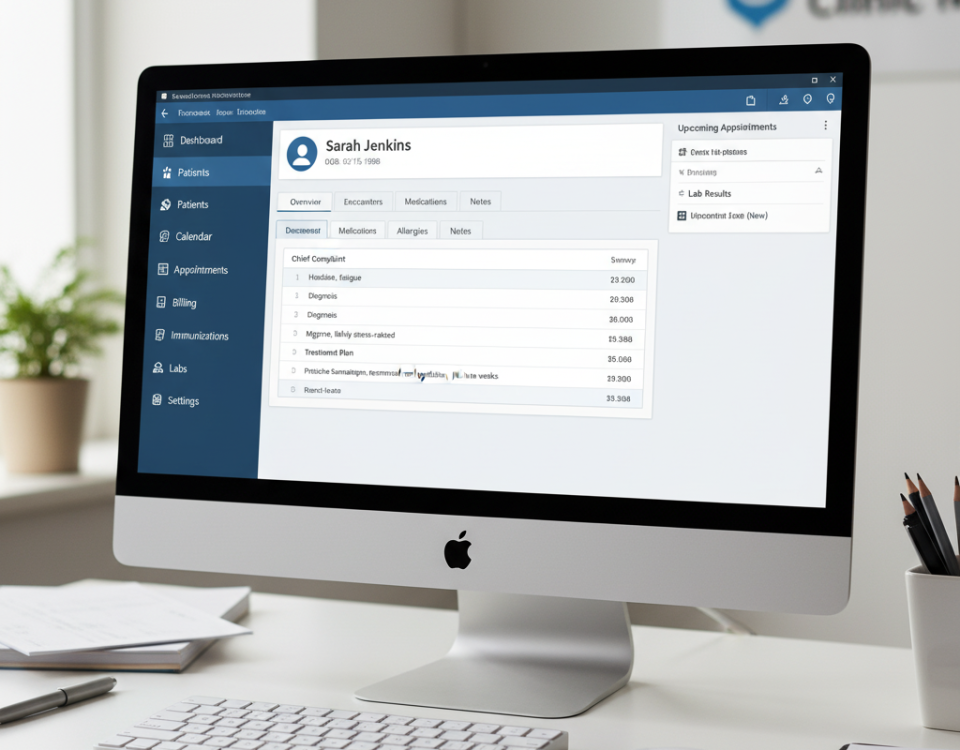- Home
- About Us
- EMR Features
-
-
- EMR Features
-
- Patient Health Features
-
- Clinic Features
-
-
- Specialties
-
- Blog
- Contact Us
Why Cardiology Practices Are Switching to EMR-Integrated Billing Solutions

Cardiology practices face some of the most demanding billing and administrative challenges in healthcare. With complex procedures, high claim volumes, and ever-changing payer requirements, billing for cardiology services is anything but straightforward. Traditional billing methods, often reliant on manual processes or disconnected systems, can slow down reimbursement, increase errors, and add unnecessary stress to busy practices.
That’s why more cardiology clinics are turning to EMR-integrated billing solutions. By combining clinical documentation, coding, and claims management in a single platform, these systems streamline operations and help practices stay focused on delivering quality care. The shift isn’t just about keeping up with technology—it’s about building smarter, more resilient businesses that can adapt to the evolving demands of modern healthcare.
1. Complexity of Cardiology Billing Requires Smarter Tools
Cardiology billing services must handle a wide variety of procedures, from diagnostic tests and imaging to surgical interventions and follow-up visits. Each service comes with its own set of codes, documentation requirements, and payer rules. Missing even a small detail can result in claim denials or delayed payments.
EMR-integrated billing solutions are designed to address this complexity head-on. By connecting clinical workflows directly to billing processes, these platforms ensure that every procedure, diagnosis, and modifier is accurately captured and coded. This reduces the risk of errors and helps practices keep up with the unique demands of cardiology billing services. While emergency medicine billing software and pediatric billing software also face their own challenges, cardiology’s intricate billing landscape makes integration especially valuable.
2. One Platform for Documentation, Coding, and Claims
Juggling multiple systems for clinical documentation, coding, and billing is a recipe for inefficiency. Information can get lost in translation, and staff may spend hours re-entering data or tracking down missing details. EMR-integrated billing solutions change the game by bringing everything together in one platform.
Cardiology billing services benefit from seamless data flow between patient records, coding modules, and claims management tools. Providers can document a visit, assign the correct codes, and submit claims—all without leaving the EMR. This not only saves time but also ensures greater consistency and accuracy. The same principle applies to emergency medicine billing software and pediatric billing software, but for cardiology, where procedures and documentation are especially detailed, the benefits are even more pronounced.
3. Fewer Errors, Faster Reimbursements
Errors in billing can be costly. Incorrect codes, missing documentation, or mismatched patient information can lead to claim denials, delayed payments, or even audits. Cardiology billing services are particularly vulnerable due to the complexity of the specialty.
EMR-integrated billing solutions help minimize these risks by automating error checks and flagging potential issues before claims are submitted. Built-in validation tools catch common errors, such as incompatible codes or missing signatures, so staff can address them in real time. This leads to cleaner claims, fewer denials, and faster reimbursements. While emergency medicine billing software and pediatric billing software also benefit from these features, the impact is especially significant in cardiology, where every detail matters.
4. Better Financial Visibility for Cardiology Practices
Understanding the financial health of a cardiology practice requires real-time access to billing and revenue data. Traditional systems often make it difficult to track claims status, monitor outstanding balances, or identify trends in denials and reimbursements.
EMR-integrated billing solutions offer robust reporting and analytics tools that give practices a clear view of their financial performance. Cardiology billing services can track key metrics such as days in accounts receivable, denial rates, and reimbursement timelines. This visibility empowers practice managers to make informed decisions, optimize workflows, and address issues before they impact the bottom line. Emergency medicine billing software and pediatric billing software offer similar insights, but cardiology practices, with their high claim volumes and complex cases, stand to gain the most.
5. Improved Patient Experience with Transparent Billing
Billing confusion can frustrate patients and damage the provider-patient relationship. Cardiology practices often deal with patients who are already anxious about their health, so clear, transparent billing is essential.
EMR-integrated billing solutions make it easier to provide patients with accurate, easy-to-understand statements. Patients can access their billing information through secure portals, ask questions, and make payments online. Cardiology billing services can also automate reminders for outstanding balances or upcoming payments, reducing the administrative burden on staff. While emergency medicine billing software and pediatric billing software also improve patient communication, the transparency and convenience offered by integrated solutions are particularly valuable in cardiology, where procedures and charges can be complex.
6. Compliance with Healthcare Regulations and Payer Requirements
Healthcare regulations and payer requirements are constantly evolving. Cardiology billing services must stay up to date with coding changes, documentation standards, and payer policies to avoid compliance issues and penalties.
EMR-integrated billing solutions are built to support compliance. They update automatically with the latest codes and rules, ensuring that claims meet current standards. Audit trails and access controls help practices maintain data security and privacy. This peace of mind is invaluable for cardiology practices, which face intense scrutiny due to the high value of many procedures. Emergency medicine billing software and pediatric billing software also prioritize compliance, but the stakes are especially high in cardiology.
7. Scalable and Customizable for Cardiology-Specific Workflows
No two cardiology practices are exactly alike. Some focus on outpatient care, while others handle complex interventions or manage large patient populations. Cardiology billing services need solutions that can adapt to these unique workflows.
EMR-integrated billing platforms offer scalability and customization, allowing practices to tailor features to their specific needs. Whether managing high-volume clinics or specialized cardiac centers, these systems can handle everything from appointment scheduling and pre-authorization to post-procedure follow-up and reporting. Emergency medicine billing software and pediatric billing software also offer customization, but cardiology’s diverse service mix makes flexibility especially important.
The Future of Cardiology Practice Management
Cardiology practices that embrace EMR-integrated billing solutions position themselves for long-term success. These platforms streamline operations, reduce errors, and improve financial outcomes—all while enhancing the patient experience. As healthcare continues to evolve, practices that rely on disconnected or outdated systems risk falling behind.
The integration of documentation, coding, and claims management isn’t just a convenience—it’s a necessity for modern cardiology billing services. With the added benefits of real-time analytics, automated compliance updates, and customizable workflows, EMR-integrated solutions are quickly becoming the standard for cardiology, emergency medicine billing software, and pediatric billing software alike.
Ready to Transform Cardiology Billing? Choose Alembico EMR
Alembico EMR delivers a powerful, user-friendly platform that integrates cardiology billing services with clinical workflows. With robust features for emergency medicine billing software and pediatric billing software, Alembico EMR streamlines billing, boosts accuracy, and improves patient satisfaction. Take the next step toward smarter, more efficient practice management—partner with Alembico EMR today.
Also read:
7 Common Medical Billing Mistakes to Avoid for Ontario Healthcare Providers
Tags: EMR software, EMR systems in Ontario, Medical Billing Software


